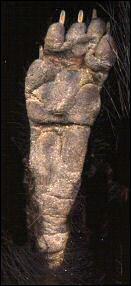

Did you know that you are a plantigrade creature, as are such animals as porcupines and bears? Or that a bobcat is digitigrade and a horse unguligrade? No, these words aren't commenting on moral status or astrological sign. These are biological terms referring to the construction of feet and how they meet the turf.
Plantigrade means that the whole foot—heel to toes—meets the ground.
Digitigrade refers to toes and fingers—the digits. Thus digitigrade animals, like our
desert foxes and rodents, walk on their toes, with the heel of the foot well off the
ground. This lengthens the legs, giving them four segments to each limb instead of our
three. Our Pronghorn and deer carry things yet further. They are unguligrade, referring
to walking on the very tip of the toes, giving them what some people think is a
backwards-facing knee—actually the heel, far up the leg. The knee is much higher and
almost concealed. The extreme lengthening helps adapt these animals for fast
running—for a cursorial way of life.

Contributor: Arthur H. Harris, Laboratory for Environmental Biology, Centennial Museum, University of Texas at El Paso.
Desert Diary is a joint production of the Centennial Museum and KTEP National Public Radio at the University of Texas at El Paso.

Plantigrade hind foot of a Western Spotted Skunk (Spilogale gracilis). Scanned dried specimen.
Feldhamer, G. A., L. C. Drickamer, S. H. Vessey, and J. F. Merritt. 1999. Mammalogy. McGrawHill, Boston. 563 pp.
University of Michigan Museum of Zoology